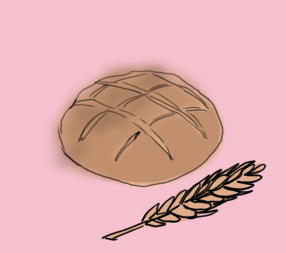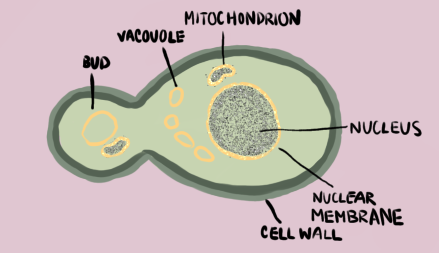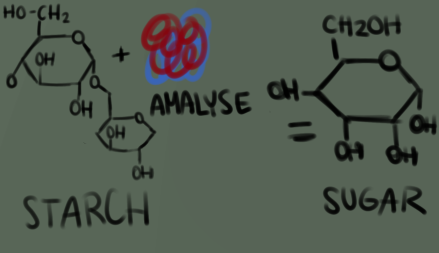How Does Yeast Contribute to Sourdough Bread?
- Science Holic
- Aug 6, 2025
- 3 min read
Author: Alex Yang
Editors: Jonathan Chen, Fiona Cheng
Artist: Emily Hu

Have you ever wondered why sourdough is so popular throughout social media? Sourdough differs from the yeast that commercial breads use because it’s a natural fermentation process caused by wild yeast and lactic acid bacteria. Yeast performs an enormous range of essential functions. From texture in bread to taste management and dough development, it is yeast that bestows identity upon sourdough.
The wild yeast in sourdough mainly consists of Saccharomyces cerevisiae, Candida milleri, and Kazachstania exigua. These are not packed but hand-selected from the air. They arise naturally on flour, in the atmosphere, and even on the hands of the baker. Flour and water left combined at room temperature will have yeast start to ferment the carbohydrates in the flour and grow. This combination, within days, will create what is referred to as a sourdough starter.

Leavening, or the process of causing the dough to rise, is the most significant thing yeast does in sourdough bread. When yeast ferments sugars in flour, it releases carbon dioxide gas. The gluten structure in the dough holds the bubbles of gas, and the dough rises and increases in size. This provides the light crumb and loaf volume of sourdough bread. As opposed to commercial yeast, which works fast, wild yeast for sourdough is slow. Slow rising allows time for bread texture and flavor to develop. Slow rising also creates time for enzymes in the flour to digest hard carbohydrates and proteins to break down the bread. Yeast has a major impact on sourdough fermentation. There is a proportion of lactic acid bacteria that are solely of the Lactobacillus type. The bacteria in the bread, lactic and acetic acids, create the distinct sour flavor. It not only gives it a unique taste but also preserves the bread by creating an acidic environment that is resistant to spoilage. The yeast and the bacteria are symbiotically related to one another. The bacterial acids inhibit the development of unwanted microorganisms because the yeast prefers a weakly acidic pH and continues to ferment the sugar. This provides sourdough bread with its characteristic flavor and natural chew. Flavor development, such as sourness, is also created by the yeast.
Flavor is pushed off when bread and other molecules transfer the flavor to bread. Carbon dioxide gas from the yeast contributes to the texture of bread. When the gas expands as the bread heats, it forms irregular holes in the crumb that contribute an open texture to sourdough. Another addition to the sourdough bread texture is slow-controlled yeast movement. Slow fermentation provides enough time for gluten network formation and extension in general without forming any tears. It thereby provides a chewy but tender interior and crispy caramelized crust. Yeast end products also contribute towards increasing the Maillard reaction during baking—a chemical reaction between amino acids and reducing sugars that contributes towards browning and deep roasted flavor in the crust. Beyond taste and texture, yeast fermentation in sourdough also has some health benefits. The extended fermentation period allows phytate enzymatic hydrolysis in flour, which is a plant nutrient that chelates minerals in the gastrointestinal tract.

Some of the gluten is destroyed as well by the process of fermentation and is digestible to one who has only a mild gluten intolerance (not for celiacs, however). Sourdough bread is also lower glycemic than most breads and will produce a slower, longer rise in blood sugar. Yeast's function in sourdough bread is not only leavening; it also influences several aspects of the bread, including its flavor, texture, and nutrition profile. It's all part of the total whole system that converts plain ingredients—flour and water—into a healthy, tasty, and long-lasting food. Yeast is mixed with flour, forming lactic acid bacteria and contributing to the shape, texture, and tang that characterize sourdough bread. Prolonged, gradual fermentation of the yeast makes available the full strength in the grains, making the sourdough not only better flavored, but also healthier and more digestible. Any sourdough bread is the result of an elegant, intricate ballet, and the yeast is the darling in this case.
Citations:
Kubala, J. (2021, November 15). Sourdough bread: Nutrients, benefits, and recipe. Healthline.
El Khoury, D., Khaled, M. B., & Landberg, R. (2024). Sourdough bread and its impact on
postprandial glycemia: A review of current evidence. Current Research in Food Science, 7,
Faulkner, J. (2024, February 21). What to know about sourdough bread. Verywell Health.
Lopez, H. W., Leenhardt, F., Coudray, C., & Remesy, C. (2002). Minerals and phytic acid
interactions: Is it a real problem for human nutrition? International Journal of Food
Science & Technology, 37(7), 727–739. https://pmc.ncbi.nlm.nih.gov/articles/PMC3231922/
Minervini, F., De Angelis, M., Di Cagno, R., & Gobbetti, M. (2014). Ecological parameters
influencing microbial diversity and stability of traditional sourdough. International
Journal of Food Microbiology, 171, 136–146.



Comments